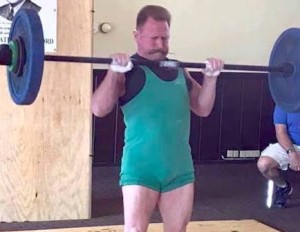Mokkie
By Bill Clark
A few months ago, Clark’s Gym kicked off a challenge to anyone in the world age 40 and older to do a different lift for each year of their life. The challenge is called “Lift Your Age.”
For such an effort, Clark’s Gym sends you a certificate of achievement – a simple, unframed piece of parchment worth less than the postage required to mail it. But, like an Olympic medal, face value is not important. It is the effort made to beat the challenge.
The latest to “Lift Her Age” was a 57-year-old recently recovered cancer victim from Lee’s Summit named Amorkor Ollennuking.
She joins Boone County’s Northern District Commissioner, Janet Thompson, as the only two women to accept the challenge and win. Thompson is the senior one of the two – at age 63.
Unlike Thompson, who had never been in a weightlifting meet of any kind in her 63 years, Amorkor, who goes by the handle of “Mokkie,” has a long record of success in the strength world.
She has been nationally ranked as an Olympic lifter, as a power lifter and as a physique contestant. She has dominated the record book in the U.S. All-round Weightlifting Association as well as the Show-Me State Games powerlifting record book.
Mokkie had lifted earlier this year in a February meet at Clark’s Gym and apologized for not being up to her usual self but didn’t tell anyone why. And no one asked.
She had just succeeded in a challenge much tougher than “Lift Your Age.” She had emerged from a year-long battle with breast cancer and was no longer in chemotherapy and radiation. She was happy to return to competition and battle again with the record book, not cancer.
Mokkie had dominated the Show-Me State Games power meet in 2018 and soon after learned that she had breast cancer. An operation brought the removal of 12 lymph nodes – seven of them cancerous – and sent Mokkie on lengthy rounds of radiation and chemotherapy.
When she lifted here in February, the portal for the chemo was still imbedded.
Mokkie returned home and her health continued to improve and she decided to tackle the challenge to “Lift Her Age.”
She did the first 17 lifts in her home gym, then called and said she wanted to return to the friendly confines of Clark’s Gym where she could do some personal records with a two-inch barbell, an implement not found in most gyms.
It turned out to be an amazing day. In a marathon that lasted seven hours, this amazing 57-year-old of Ghanan descent, did 45 different lifts – 33 of them with the two-inch barbell – to log 65 – not 57 – different lifts and said she would be back next weekend in an effort to extend her challenge to 100 lifts to match Ol’ Clark’s effort last month.
She returned Saturday past and finished off the 100 and seemed ready to do 100 more. I grew very tired just watching and judging her efforts.
There was no comparison between Ol’ Clark and Mokkie. She did it with more weight than Yours Truly. And she weighed only 159 1/2 pounds, 50 pounds less than Ol’ Clark.
I was in awe.
So, who in the hell is this dynamo and how did she get here?
Amorkor (pronounced Amoko, The “r’s” are Ghanan additions to local English) was born, Christmas Day in 1962, in Mainz, Germany, where her father, Nil Amaa Ullennu, was a medical student. Her mother, Elizabeth Roane, was from Virginia and the couple had met and married at Howard University. Her father was a native of Ghana; her mother of mixed race.
Her older brother, Koi, owns a doctorate in mechanical engineering; her older sister, Amerley, works in marketing for the Washington Post.
The family returned to Richmond, Virginia, when Mokkie was nine, moving to New Carrollton, Maryland, when Mokkie was in the 10th grade. She graduated in 1981 from Northwestern Senior High, but had played no sports. Her dad had returned to practice medicine in Ghana. Lifting was not a part of the Ollennu family life.
Except for Amorkor.
When she was hardly old enough to walk, she remembers watching Vasily Alexeev, the great Russian heavyweight, in action and she never forget the thrill of watching him ram almost 600 pounds overhead.
She had watched the power lifting class in high school, but the family lacked the funds to enroll her.
By 1983, she decided to join the Marines and it was while stationed on Okinawa that she began training with the power lifters and lifted in her first competition – a two-lift affair that had only the squat and bench press.
“I remember my first lifts – a 315 squat and a 185 bench at 148 bodyweight. (She now remains a very trim 160).
After four years in the Marines, she returned to civilian life, became deeply involved with bodybuilding, renewed friendship with a fellow Marine she met in Okinawa, named Vernie King, and they married in December, 1988. He remains her coach and husband in whichever order the day requires.
In 1989, Mokkie won the bodybuilders’ version of “Miss Missouri” and year later added the championship of the North America Natural Bodybuilding Association.
By 1992, she had earned her pro card in the Natural Bodybuilding Federation, and in that same year, ran into Jon Carr, who had built a major Olympic-style weightlifting program at Wesley Center in St. Joseph.
She was hooked. Training with Carr and at home, she won a berth three times at the U.S. Olympic Festival winning a silver and bronze and medaled one year at the U.S. National Championships.
She got better with age and won the 35-39 age group at the World Masters Championship in Orlando, Florida. In 2002, she represented Ghana at the British Commonwealth Games (Ghana had been a British colony and as still a member of the Commonwealth). She finished sixth at age 39.
Along the way, she added at least one national power lifting title and has won the Show Me State Games power meet in each of the five years she has competed, twice winning with a 220-pound bench press.
In recent years, she has been very active in the all-rounds – also known as the odd lifts. Thus, she had no problem in mastering the 100 lifts she performed in less than three weeks in September.
She credits Joe Caron of Iola, Kansas, for introducing her to the odd lifts, where she has set dozens of records. Joe is a long distance member of Clark’s Gym and, at age 75, one of the seven gym members who have now joined the “Lift Your Age” club.
And Vernie? He squatted 400 in high school but has never competed later in life. “He’s my essential coach,” Mokkie is quick to tell you.
In discussing her failure to move into the international level, she sums up her career with one brief sentence: “I have always lifted drug-free.” ‘Nuff said.
To stay in shape, Mokkie rides her bicycle and uses her tricycle to haul groceries home. She and Vernie have a large home gym where she trains and walking three dogs – the smallest which weighs “only”55 pounds – keeps one in shape.
A quick look at her best-ever lifts – Clean and jerk – 209 pounds; snatch – 154 pounds; squat – 405; dead lift – 405; bench press – 225; the very difficult Steinborn Lift – 225; Zercher lift – 315; leg press – 450; hand and thigh – 1,150; hip lift – 1,325; harness lift – 1,705.
And now she becomes the first female to do 100 different lifts when she meant to do only 57.
Mokkie is one of a kind as her oncologists have discovered.


